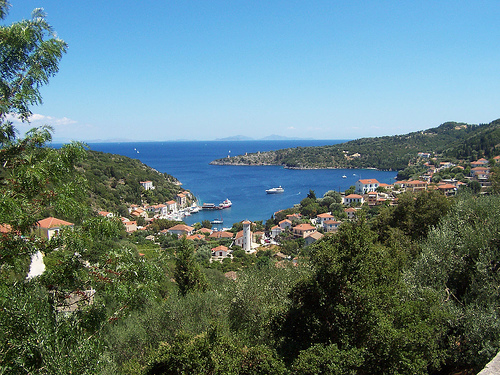

Location: Ionian Islands Map
"I dwell in shining Ithaca. There is a mountain there, high Neriton, covered in forests. Many islands lie around it, very close to each other, Doulichion, Same, and wooded Zacynthos-- but low-lying Ithaca is farthest out to sea, towards the sunset, and the others are apart, towards the dawn and sun. It is rough, but it raises good men." (Odyssey)
Ithaca, or Ithaki (Greek: Ιθάκη), is a picturesque Greek island in the Ionian Sea, located off the northeast coast of Kefalonia and west of mainland Greece, forming part of the Ionian Islands regional unit. Renowned worldwide as the legendary homeland of Odysseus from Homer's Odyssey, it symbolizes the epic journey and return home, blending myth with serene natural beauty. The island spans 96 square kilometers (37 square miles) and, as of the 2021 census, has a population of around 2,862 residents, making it the second-smallest inhabited island in the traditional Heptanese (Seven Islands) group. Ithaca offers a tranquil escape with lush greenery, rugged landscapes, crystal-clear waters, and charming villages, ideal for nature lovers, hikers, and those seeking an authentic Greek island experience away from mass tourism. In 2025, it remains a peaceful destination emphasizing sustainable tourism, with activities like sailing, scuba diving, kayaking, and cultural immersion. The capital and main port, Vathy (or Vathi), serves as the hub, while smaller settlements dot the island's two main landmasses connected by a narrow isthmus.
Ithaca's history is deeply intertwined with mythology and archaeology. In Homer's Odyssey (circa 8th century BCE), it is Odysseus's kingdom, where he returns after 20 years of adventures following the Trojan War. Ancient sites like the ruins at Pelikata and Aetos suggest Mycenaean settlements from 3000-1000 BCE, with evidence of palaces and fortifications potentially linked to the Homeric era. The island was inhabited since the Neolithic period, with influences from Minoan, Mycenaean, and later Corinthian colonizers. During classical times, it was part of the Corinthian alliance and later under Roman rule, thriving as a trade hub. In the Byzantine era (4th-12th centuries CE), monasteries and churches were built, followed by Venetian control (1500-1797), which left architectural marks like fortresses. The Ottoman period (1797-1864) saw resistance, and Ithaca joined modern Greece in 1864. The 1953 Ionian earthquake devastated much of the island, leading to reconstruction in traditional styles. Today, archaeological excavations continue, debating whether ancient Ithaca matches the modern island or nearby areas. In 2025, cultural festivals celebrate this heritage, blending ancient myths with contemporary interpretations.
With a small population of about 3,000 (including seasonal residents), Ithaca maintains a close-knit community centered on family-run businesses and traditional lifestyles. The economy relies on tourism, agriculture (olives, wine, honey), fishing, and small-scale shipping. Olive oil from ancient trees is a prized export, and local products like cheese and herbs support eco-friendly initiatives. Unemployment is low, but youth migration to mainland cities is a challenge. Infrastructure includes ferries from Kefalonia, Patras, and Astakos, with no airport—visitors fly into Kefalonia and transfer by boat. Roads wind through hills, connecting villages like Vathy (population ~1,800, with neoclassical buildings and a natural harbor), Kioni (a yachting haven), Stavros (with Odysseus bust), and Anogi (highland settlement). In 2025, sustainable development includes solar energy projects and eco-tourism, with the population stable but boosted by summer visitors. The island's quiet pace contrasts with busier Ionian neighbors, fostering a sense of timelessness.
Ithaca's attractions highlight its mythical and natural allure. Key
sites include:
Beaches: Gidaki (secluded, boat-accessible with
clear waters), Filiatro (family-friendly near Vathy), and Sarakiniko
(twin bays with pebbles). Skinos and Mnimata offer wild, untouched
vibes.
Mythological Sites: The Cave of the Nymphs (where Odysseus hid
treasures), Fountain of Arethusa (from the Odyssey), and archaeological
ruins at the School of Homer (Pelikata Hill) with Mycenaean walls.
Villages and Landmarks: Vathy's Archaeological Museum displays ancient
artifacts; Kioni and Frikes are colorful ports for sailing; monasteries
like Kathara (with panoramic views) and medieval ruins in Anogi.
Outdoor Activities: Hiking trails (e.g., to Aetos for views), diving
spots with wrecks, and boat tours to coves. The Odysseus Festival in
summer features music and theater.
Visiting in 2025: Peak season
(June-August) sees mild crowds; shoulder months (May, September-October)
are ideal for hiking (temperatures 20-25°C/68-77°F). Ferries run daily;
accommodations range from boutique hotels in Vathy (€100-200/night) to
villas. Entry to sites is free or low-cost (€3-5 for museums). Rent a
car or scooter for exploration, as public buses are limited. Check
ithaca.gr for updates on events and ferry schedules. Ithaca promotes
responsible travel, encouraging eco-friendly practices like waste
reduction.